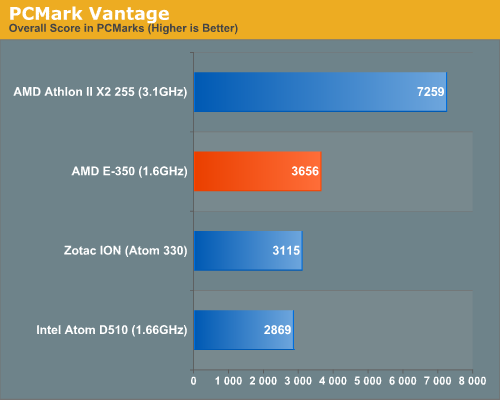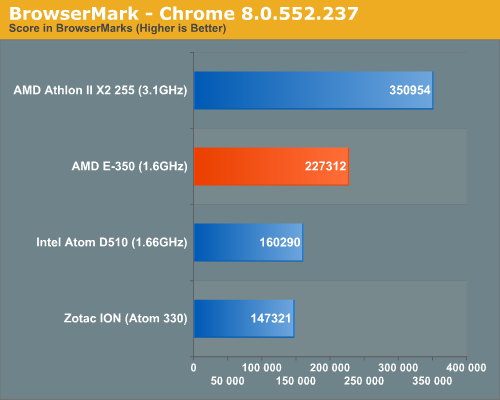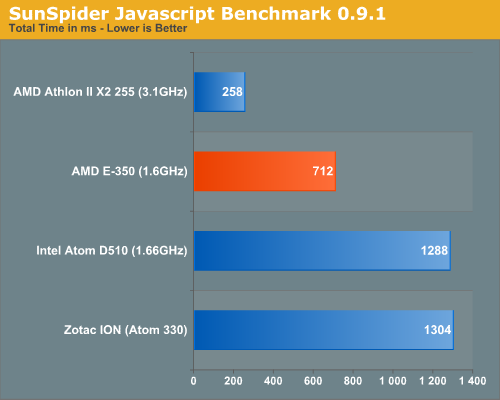The Brazos Review: AMD's E-350 Supplants ION for mini-ITX
by Anand Lal Shimpi on January 27, 2011 6:08 PM ESTGeneral Performance: In Between Atom and Athlon II
Atom may be efficient and fast enough to run a smartphone OS, but it absolutely chugs on Windows 7. The seat of the pants feel of an AMD E-350 is noticeably better. Single threaded performance, as you’ll soon see, is easily twice that of a similarly clocked Atom. Bobcat is still a dual-issue dual-core machine so high IPC or highly threaded workloads will show little difference between it and Atom. Thankfully, for most entry level netbook/nettop workloads Bobcat’s architecture should be sufficient. Before we get to the more CPU intensive tests I wanted to run through some reader requests for performance characterization.
I’ll start out with PCMark Vantage. There’s very little that separates PCMark from SYSMark in terms of how realistic the workload is. Neither suite is particularly representative of what an average user does today. What these suites are good at is being very long, and stressing enough aspects of a platform to give you a general idea of performance. SYSMark tends to focus on the more heavy user/content creation side of things (optimized for no more than 2 cores), while PCMark Vantage is much lighter test.
Looking at SYSMark you’d see no performance difference between the E-350 and Atom. The reason is simple. SYSMark was designed to be a modern day CPU benchmark. Most of the workloads exhibit high IPC and thus Bobcat’s front end acts as a bottleneck.
While SYSMark can be useful in estimating how a processor might handle particular heavy workload, it’s not useful in characterizing the sort of light workloads that you’d see a netbook or nettop user creating. PCMark Vantage is a collection of far simpler tasks. Again not specifically what you’d do today, but lighter nevertheless.
I compared four systems using PCMark Vantage, all with the same memory and I/O configuration. I dusted off an Atom 330 + ION motherboard from Zotac, an Atom D510, the MSI E-350 board and an Athlon II X2 255 on an 890GX motherboard. I picked the Athlon II simply because it’s a very affordable (~$65) modern day dual-core CPU. The Athlon II will help put the E-350’s performance compared to modern day x86 cores in perspective.

The E-350 holds a clear advantage over the Atom D510. The overall suite runs 27% faster on the E-350 than the D510, and even 17% faster than ION (the overall suite includes some GPU tests where ION makes up for Atom). The advantages vary from 10 - 80% in most cases. If you look at tests where the GPU is involved, you have to start counting how many times Brazos is faster than Intel’s current Atom platform.
I have to put the E-350’s dominance in perspective however. An Athlon II X2 255 still delivers nearly 2x the performance of the E-350 in PCMark Vantage. Just as the Atom to E-350 jump is noticeable, so is the jump from an E-350 to an Athlon II.
A performance advantage in PCMark is often difficult to visualize so let’s move on to some more application specific tests. Next up are two web browser benchmarks we typically use in our smartphone reviews: BrowserMark and SunSpider.
BrowserMark is a general purpose browser test. Rather than loading full web pages it tests rendering speed for commonly used components of web pages and presents one gigantic score at the end to tell you which platform is faster. The benchmark is obviously browser dependent so I ran all numbers on the same version of Chrome (8.0.552.237). The test platforms were the same as before:

The E-350 holds a 41% performance advantage over the Atom D510 here. That’s definitely enough to be noticeable in actual usage. In general web browsing is noticeably faster on Brazos than on Atom. The Athlon II is another 50% faster than the E-350. Again, it’s enough to be noticeable.
SunSpider is a collection of javascript benchmarks that we typically run to compare smartphones. It ends up being a good way to compare one aspect of web browsing performance between these entry level platforms.

The Brazos advantage over Atom actually climbs when we look at pure js performance. The E-350 is 80% faster than the Atom D510 here. The Athlon II advantage grows as well. Web browsing can be very CPU bound at times.
Brazos, like Atom, will never compete with its bigger brothers. There’s only so much you can do with a very tiny die. What AMD’s platform does provide however is a stepping stone between Atom and the lower end beefy x86 cores, which is something we’ve needed.
Many of you wanted even more real world testing, focusing on things like application launch time and system boot time. Ask and you shall receive is one of our policies around here (within reason) so I put together a drive image with a ton of applications, games and data. I measured the time it took to boot to the Windows 7 desktop as well as timed individual application launches.
Boot time is a difficult thing to compare between platforms. Everything from BIOS optimizations to the type of video card you have in the system can impact boot time. In this case, the E-350 system managed to boot 13% faster than the Atom system.
Individual applications, specifically light weight apps (e.g. Google Chrome, Media Player Classic), launch relatively quickly on both Atom and Brazos. This is largely due to the fact that I’m testing with an SSD. Regardless there’s still no appreciable difference in launch time between the platforms when the drive bottleneck is removed (the difference doesn’t grow as you add bottlenecks in). Where we see the E-350 really shine is in the larger, more complex applications and games.
| Application Launch Time Comparison | |||||||||||
| Platform | Boot Time (POST to Desktop) | Adobe Reader 9 | IE8 | Chrome | MPC-HC | Cinebench 11.5 | Sonar 8 | CoD: Black Ops | Starcraft II | ||
| AMD E-350 (1.6GHz) | 61.5s | 2.2s | 1.4s | 1.4s | 1.2s | 5.5s | 8.8s | 15.0s | 21.9s | ||
| Intel Atom D510 (1.66GHz) | 70.3s | 1.5s | 1.4s | 1.4s | 1.2s | 3.9s | 10.3s | Fail | 39.8s | ||
| AMD Athlon II X2 255 (3.1GHz) | 53.8s | 1.0s | 0.8s | 0.7s | 0.7s | 2.5s | 4.5s | 5.3s | 9.9s | ||
Sonar 8 launched 17% faster on the E-350 vs. Atom, while Starcraft II launched in almost half the time of the Atom D510 (although I suspect part of the advantage there is GPU related). Not all application launches were faster on the E-350. Occasionally applications would launch faster on the D510, but that seemed to be the exception rather than the rule. Overall system performance is naturally faster on Brazos compared to Atom.
Bring the Athlon II into the picture and things look different. You can cut most of Brazos’ launch times in at least half to get an idea of the Athlon II’s performance.










176 Comments
View All Comments
tno - Thursday, January 27, 2011 - link
http://www.anandtech.com/show/4017/vias-dual-core-...Not a full review but darn close.
e36Jeff - Thursday, January 27, 2011 - link
they did, its here:http://www.anandtech.com/show/4017/vias-dual-core-...
Problem is that what they tested was basically an engineering sample built on the wrong node, they havent gotten anything to market yet, so actual numbers from real products are unknown. having said that, yeah it does look like it might be better, but until someone makes a product based on it, we'll never know.
nitrousoxide - Thursday, January 27, 2011 - link
The price itself is stopping Nano X2 from dominating APU or Atom in the compete. The Nano platform consists of 3 different chips (aka CPU, NB, SB as the traditional layout) but the latter two managed to do that with only one chip, especially APU with very small die size. While Nano X2 is an impressive part compared to APU and Atom in absolute performance, it's not competitive in other features such as die size, price and power consumption.Tralalak - Friday, January 28, 2011 - link
AMD Zacate TDP Configs@18W + Hudson M1 = Fusion Controller Hub = ("South Bridge") TDP Configs@2,7W to 4,7 W for typical configurations === AMD Brazos 20,7W to 22,7W TDP. (2 chip solution)VIA say: VIA Nano X2 have some TDP than VIA Nano Single-Core.
VIA Nano X2 1.4GHz (40nm TSMC) have some TDP than VIA Nano U3200 1.4GHz (65nm Fujitsu) TDP = 6.5W
VIA Nano X2 1.4GHz max. TDP@6.5W + all-in-one chipset VIA VX900 MSP (Media System Processor = North Bridge (IGP) + South Bridge) max. TDP@4,5W === max.TDP@11W (2 chip solution)
I mean that In "minibotebook market" is very competitive.
VIA's 40nm next all-in-one chipset VIA VX MSP with DirectX 11 IGP refresh will appear in Q4 2011.
mczak - Monday, January 31, 2011 - link
VX900 has Chrome9 HC3 graphics core at 250Mhz - the same as VX800. Its 3d performance can barely keep up with the atoms anemic IGP (I could not find ANY review of VX900, just VX800), so totally no match for Brazos (though, in contrast to atom, it should support video decode much better). So your TDP comparison basically ignores the 3d part of it (surely the graphics core won't consume that much given its performance).Alright, even if I were to believe the DC Nano has same TDP as the current single core one, traditionally perf/power has never been that good with those VIA chips (not terrible, just not really good). Maybe their TDP definition is different (btw I've never seen a published TDP figure for any of the nano u3xxx series, which you seem to use as reference), also keep in mind runtime of notebooks is barely affected by TDP, much more important if you can get low idle power figures. I have no idea how the VIA platform would compete there (granted the publish idle power of the nano u3xxx cpus is only 100mW), but based on past designs I have to assume not very well (fwiw, this article here doesn't help for that neither, since the atoms don't have all of their mobile siblings power management features enabled).
So, unless VIA delivers, I remain sceptical if they can be competitive. Yes, a 1.4Ghz Nano DC should be quite competitive with 1.6Ghz Zacate performance wise - maybe also power wise, but 3d graphics will be very very sub par. To catch up in that area the new IGP is needed which as you mentioned is q4 (if the graphic core is like VN1000, it should do quite well, though I'll note that VN1000 plus the required southbridge has a 12W TDP).
bjacobson - Saturday, January 29, 2011 - link
I for one will be clicking any links with more info on these nanos! That sorely beat the Brazos out of nowhere hah!I doubt the it'll be much good at games though, and the drivers will be rough.,,
silverblue - Monday, January 31, 2011 - link
I've seen the Nano in comparison with Brazos before so I knew it was capable of being faster, however it'll take a load more power.The last time I saw a proper Nano rundown, we were talking a 65nm chip...
Iketh - Thursday, January 27, 2011 - link
power consumption is considerably higher on NanoAmdInside - Thursday, January 27, 2011 - link
Just curious if it was a fad or are people still buying Atom systems? I bought an Atom netbook but sold it within 30 days cause I couldn't stand it (Dell Mini 10v). Then I bought an ION Zotac Atom 330 system to use as a video streaming device for my bedroom and while I do like it for what it does, I just can't see myself buying another cheap lower powered Atom/AMD E-350 like device. I bought mine because the price made it seem like a great deal but once I got past that, I just lost interest in netbook/low powered mini-ITX platforms. Tablets on the other hand I am still hooked on. Love my iPad and may pick up a second this year and pass mine onto my wife.nitrousoxide - Thursday, January 27, 2011 - link
What APU/Atom can do is still far beyond ARM-based tablet's reach. Just look at how much superiority x86 have in absolute performance. E-350 has roughly 5 times the performance of Tegra 2, and even an Atom is significantly faster. So tablet is just an alternative of nettops, not a replacement. If you are fine with you iPad that's cool, but saying that nettop is dead is still far too early.The superiority of x86 is just unmatched by ARM, and that's why Intel claims that ARM is not a big deal for it. Want to be as fast? Then add more instructions sets, design more complicated architectures, and what you get is no longer an ARM.